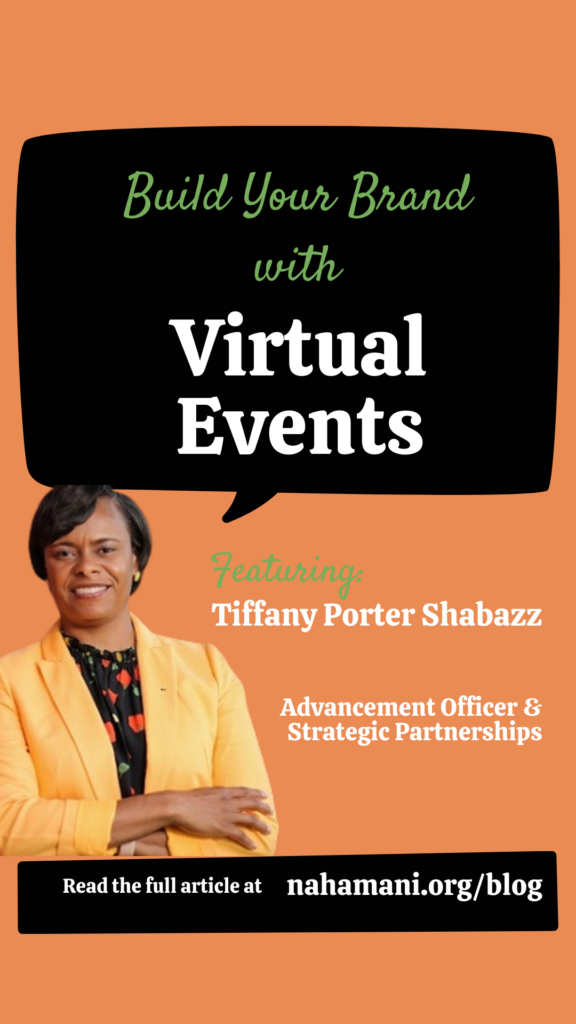Hosting virtual events has become a popular way for businesses to stay connected with their customers and stakeholders in the past year, and we think it’s safe to say their popularity is here to stay.
While planning a virtual event doesn’t completely throw out the rule book for planning an in-person event, you’ll quickly realize there are differences between the two. So how do you start planning a virtual event?
Plan Ahead
Just like with an in-person event, you’ll need to leave plenty of time to plan and create a timeline for your event. Even though it’s a virtual event, you will need to make decisions on the platform you would like to host the event on, figure out how to get word out about the event, coordinate who will be speaking and presenting, think about how to engage your audience, decide whether it will be live or filmed (or maybe both), and consider additional programming to increase engagement and interest, like silent auctions or photo contests.

Tiffany Porter Shabazz, Advancement Officer & Strategic Partnerships at The Christ College of Nursing and Health Sciences, has first-hand experience planning a virtual event while overseeing the planning of the college’s virtual fundraiser, Healthcare Heroes Made Close to Home. Porter Shabazz said time was vital in making the event successful. “The longer you have in terms of timeline to start to plan, organize and execute, the better,” said Porter Shabazz.
Set a Time Limit
Unlike in-person events, you will most likely need to cut down on your ceremony content and time, as attention will wane faster. Keeping your event length within 1-hour is a good rule of thumb to keep your audience entertained and engaged. “It’s more important to engage our audience and get the messaging across and to do that in a thoughtful way but also be timely about it,” said Porter Shabazz. If your event ends 15-minutes early or runs over, don’t sweat it; just make sure you provide quality and meaningful content to your attendees and keep them actively engaged.
Consider Your Audience
Just like when planning an in-person event, you need to figure out ways to engage the different groups and stakeholders you want to target before, during, and after your virtual event.
From the beginning, Porter Shabazz kept in mind what she wanted The Christ’s College’s virtual fundraiser to be like and even more, who she wanted to target. “We wanted to have an opportunity or experience that drew our alumni, our friends, as well as students and parents and the general public, so it worked as a fundraiser but also worked as an opportunity to create more visibility for the college,” said Tiffany.
Make sure to consider the end-users point of view for what they would like to see from your event, what would interest them in attending, and the direct benefits of attending the event.
Avenues for Getting the Word Out About Your Event
So how do you reach your intended audience and spread the word about your event? You’ll need to consider different methods and platforms, both old-school and new, to spread the news.
First, create an event on your business’s Facebook page and frequently make posts leading up to the event to promote it. It’s important to tell your brands’ story before, during, and after the event to build interest. Also, make sure your event is posted on your business’s website and easy for potential attendees to find.

Second, even though it’s a virtual event, it’s best to send out both printed and electronic emails to invite guests. Sending both hard-copy and virtual emails will ensure you reach people who may not be on your email listserv and vice versa.
Third, let the media know about your event! Send out a media advisory to grab the attention of news and magazine outlets relevant to your event so that they can help promote it to an even wider audience.
Overall, make sure your message is clear and personal to each unique audience.
Audience Engagement
One of the most essential elements of planning a virtual event is making sure your audience engaged before, during, and after the event. For the Christ College of Nursing and Health Sciences’ event on May 6th, Porter Shabazz planned to get attendees engaged and further promote the event by opening their silent auction a week before the event. As well, they created Hero Event Kits that the first 100 registrants would receive that included a hero mask for attendees to strike their best hero pose to use on social media and throughout the event.

To promote engagement during the event, consider using a hosting platform that allows for audience members to chat through a message board throughout the event and make sure to utilize this by asking questions throughout the presentation.
You can also use the powerful art of storytelling throughout your event to build a connection between attendees and your business during the ceremony. Pre-recorded videos of a customer, alumni, member, etc. are great resources for showcasing the impact your business has had on an individual or community and further build a connection with your audience.
After the event, keep the party rolling by creating stories on social media and newsletters to let people know how successful the event was and how to stay involved once the event is over. Remember, it’s one thing to get people to attend your event, but you’ll also want to keep them as avid listeners and supporters of your business for years to come.



